Nerite snails are right at the top of the list, with mystery snails for the most popular algae eaters.
They’re small, easy to care for and get along well with many freshwater fish pets.
So, let’s get into what nerite snail care looks like so some of these guys can join your tank as soon as possible!
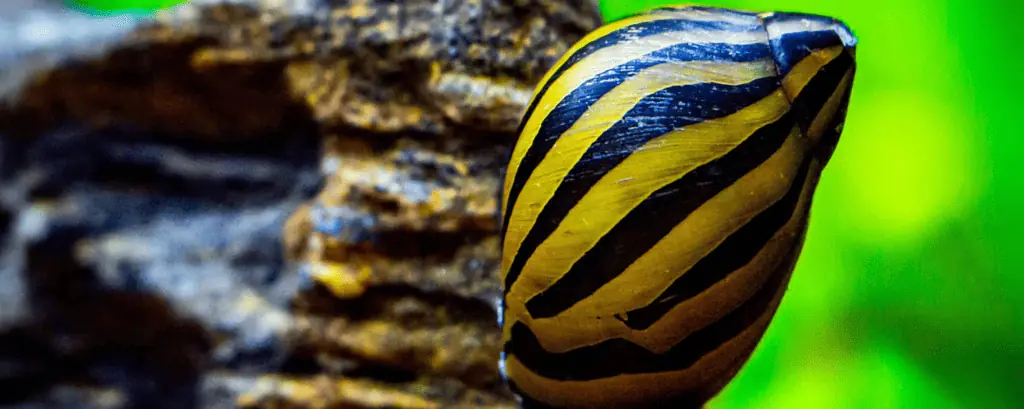
Table of Contents
Nerite Snail Overview
| Common names | Nerite snail, spotted nerite, zebra nerite, horned nerite |
| Scientific name | Vittina natalensis |
| Origin | East Africa |
| Water type | Freshwater, brackish water, salt water |
| Care level | Easy |
| Lifespan | 1-2 years |
| Price | $2-5 per snail |
| Tank size | 5+ gallons |
| Temperament | Calm, peace-loving |
| Size | ~1” inch |
| Diet | Herbivore |
| Dietary needs | Calcium |
| Water temperature | 72-78° degrees Fahrenheit (22-25.5° C) |
| pH | 7.5-8.5 |
| Freshwater hardness | 6-12 dgH |
| Saltwater hardness | 12-18 dgH |
| Color varieties | Green, brown, black, gold, tan, maroon |
| Prevalence | Common |
| Breeding Difficulty | Hard |
More from us on Nerite Snails
- Why Do Nerite Snails Poop So Much?
- The Care And Keeping of Nerite Snail Babies
- Removing Nerite Snail Eggs
Nerite Snail Tank Requirements
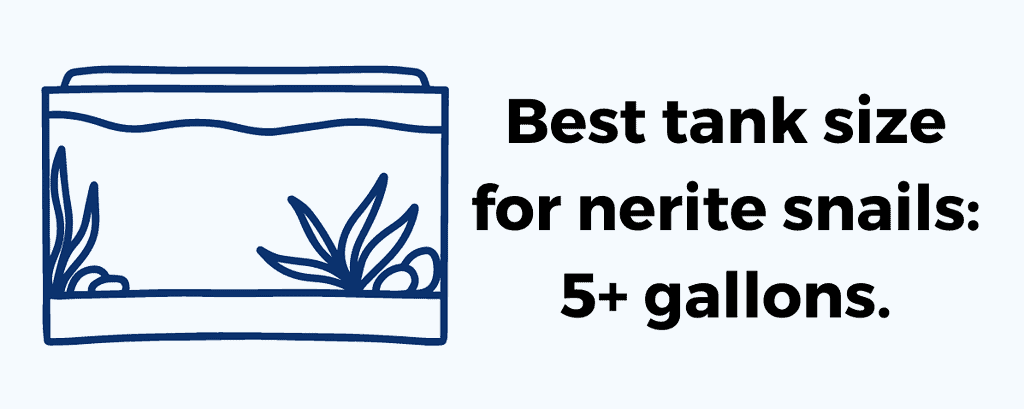
Despite being even smaller than mystery snails, nerites need plenty of space.
They move quickly compared to a lot of aquarium snails. They also enjoy scavenging for food and plant waste around the tank.
So, the best tank size for just a couple of nerite snails is 5 or more gallons. If you keep many more, upgrade the tank size accordingly.
The bigger, the better, especially when your snails have tank mates like fish or shrimp.
Aside from the basic tank equipment (thermometer, testing strips, etc.), your nerite snails will need some specific additions to their home.
Water Type & Filtration

Nerite snails do well in various environments. If you don’t already have a freshwater tank set up, we recommend setting up a brackish tank.
Brackish water is ideal for nerites, but they can still thrive in freshwater or saltwater tanks!
Freshwater aquarists love nerites almost as much as they love mystery snails. Just remember to set the tank up with their unique needs in mind.
Filtration is extremely important, for example. We suggest using a sponge filter or something equally gentle.
Filters with more intense airflow are hard on nerites and often kill the babies of the colony.
Note: Nerite snails do not reproduce in freshwater tanks, so babies are not a concern for freshwater aquarists.
This particular snail species likes to sit on the aquarium glass or filter intake and just stay stuck there for ages.
If your filter is gentle and the tank is clean, this isn’t a problem. But a high-power filter will likely harm or kill some of your snails.
Lighting

When you choose your aquarium light, look for something on the dimmer side of things.
Nerite snails are not fond of extremely bright light. In fact, many snail owners say their nerites are more active and seem happier when it’s dark in the tank.
This being said, they do need at least a few hours of moderate lighting during the day to help regulate their bodies.
If you’re gone a lot, get a light with a timer. This way, you don’t need to be home for your snails to get a break from the light.
Note: Putting your tank in direct sunlight raises the temperature and keeps the aquarium bright for too long.
Substrate and Decor
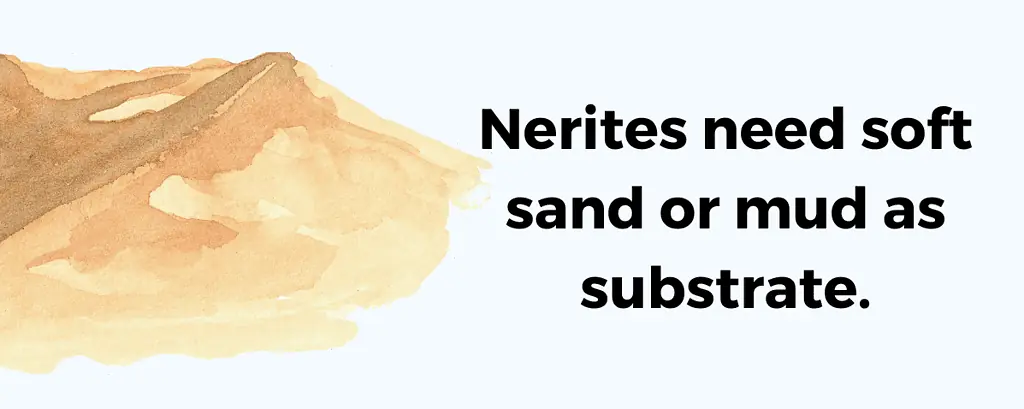
Whereas some snails like a hard surface for the bottom of the tank, nerites need soft sand or mud.
Consider using calcium sand as your substrate if you have a saltwater tank. This is a healthy option for your nerite snails in more ways than one.
Once you’ve got the substrate in the bottom of the tank, it’s time to start thinking about practical decorations.
As with any kind of fish tank, remember to get plants without hard plastic or other sharp materials.
Live plants are wonderful, but not everybody has access.
Working with what you have, here is the ideal decoration list for your nerites’ aquarium:
- Caves
- Plants
- Driftwood
These are all staples for many fish tanks, so you may already have some of them.
Caves and plants both act as sanctuaries for your snails, whether or not there are other, bigger fish in the tank.
Your snails will lust after some quiet time on occasion, and it’s nice for them to have a dark place to go.
Plants also produce some waste for your snails to eat. But more importantly, they are reminiscent of the nerite’s natural environment.
While life in captivity obviously differs from life in the wild, it’s always good to replicate your pet’s natural habitat as much as possible.
Driftwood is a good tool for this as well. But it’s also an extra food source.
Nerite snails love to chow down on wood slowly but surely.
With the combination of all three of these decorations, your snails will be well-stimulated, well-fed, and feel secure.
What Not to Add

Based solely on their ability to survive in three different types of tank water, the nerite snail would seem like a pretty flexible pet.
In truth, there are some dealbreakers to never put in their home.
Copper is toxic to snails.
I know it sounds like a strange thing to find in a fish tank anyway. But copper is actually included in some fish foods and is not a rare find in home aquariums.
If your snails have betta or other fish as tank mates, triple-check the ingredients on their food flakes or pellets.
Make sure no copper derivatives are making their way into the tank water.
Sharp or hard plastic objects are dangerous to snails.
I cannot stress this enough! Fake plants would seem harmless to the beginner aquarist.
But a fake plant could maim or kill your pet if it isn’t made of soft silk or another gentle material.
Dead snails must be removed as soon as possible as they cause ammonia levels in the tank to rise.
This puts your other snails (and fish) at risk of getting sick!
Some fish and snails will eat dead ones before long. But if you notice a dead snail, get it out of the tank.
Tank Set-Up
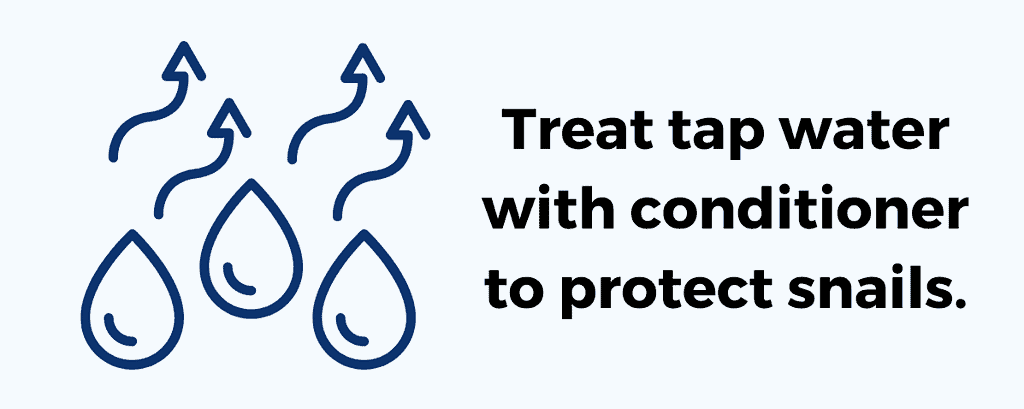
Before adding water to the tank, ensure it is up to temperature and tested well for chemical and pH levels.
If you’re using tap water, treat it with conditioner/dechlorinator to avoid making your snails sick.
Putting untreated tap water in the tank is an easy way to end up with too much ammonia or nitrite in the tank.
Sometimes copper compounds are even found in tap water.
Getting your water tested for high levels of these chemicals is smart, especially if you’re just starting out.
Your tank needs a lid!
Nerite snails are notorious escape artists. They are constantly found outside of the tank, much like mystery snails.
Keep a tight-fitting lid on the aquarium; hopefully, this won’t be too big of an issue for you.
Water Requirements
| Water Type | Freshwater, brackish water, salt water |
| Temperature | 72-78° degrees Fahrenheit (22-25.5° C) |
| pH | 7.5-8.5 |
| Freshwater hardness | 6-12 dgH |
| Saltwater hardness | 12-18 dgH |
| Ammonia levels | 0 ppm |
| Nitrate levels | 0 ppm |
| Nitrite levels | 0 ppm |
| Copper levels | 0 ppm |
Tips for Following Water Parameters
Nerite snails have a slightly higher tolerance for nitrate than the other chemicals listed here. But the goal is still to keep it at 0 ppm.
When chemical levels get out of control, it doesn’t take long for your pets to start getting sick.
Even if they don’t experience bacterial or other infections, the stress on their bodies puts them at a higher risk for problems like parasites.
This is why we recommend testing your water semi-regularly, especially when setting up your tank.
Then, every time you notice strange behavior or symptoms of illness in your snails, you know to monitor all these water parameters.
Another important habit of getting into is keeping an eye on the temperature in the tank.
It’s best always to keep a thermometer attached to the tank. This allows you to glance at the temperature whenever you think of it.
We like this so much because temperature fluctuations are shocking to snails and fish.
Nerite snails are only 1” inch in diameter. Changes as small as a few degrees feel immense to them!
Nerite Snail Diet & Feeding

They are known to be good algae eaters, but nerites eat much more than just algae growth.
Check out our complete list of algae eaters for betta fish tanks (with pictures!).
These guys consume all kinds of waste in the tank: food waste, plant waste, and even some of the waste your fish produce.
They’re a perfect aquarium cleaning crew!
This being said, they are not so adept at taking care of ammonia or other water problems.
As many adorable cleanup crew members as you have, they will not be a substitute for tank maintenance.
You will also need to be prepared to fill their special dietary needs.
Calcium for Healthy Shells

Many snail species need extra calcium in their diet to have healthy shells and bodies.
Nerites are no exception!
Get calcium into the tank at every opportunity. Earlier, I mentioned calcium sand as a calcium-rich substrate material.
But calcium supplements and calcium-dense veggies are two more great ways to help your snails get what they need.
Feeding calcium regularly in some form will promote healthy shell growth and prevent growth deformities or shell-related health issues.
Common Problems with Nerite Snails

Unhealthy Shells
Shell problems are the biggest health concern in nerite snails.
Softness, cracks and holes, and thinness or wearing down are all pretty common problems for these pets.
There are a few contributors to this:
- Acidic water
- Calcium deficiency
- High ammonia
- Aggressive fish
High acidity is tough on nerite shells. Over time, it makes them go soft or crack. This is obviously dangerous for your snails!
While they do alright in a wide range of water types, it’s crucial you stick to their preferred pH levels.
Calcium deficiency is a huge cause of shell problems. The integrity of their shells is dependent on good calcium intake.
Experienced aquarists will tell you how much of a difference it makes to get calcium into the tank as much as possible.
Nerite snails feel better, are more active, have healthier shells, and often live longer when they get sufficient nutrients.
Ammonia has a few adverse health effects for nerites. But one of the things it worsens is shell health.
Aggressive tank mates are not so great for helping your snails live healthy lives. Not only do they sometimes nip at and damage snail shells, but they also cause stress.
Other Health Issues
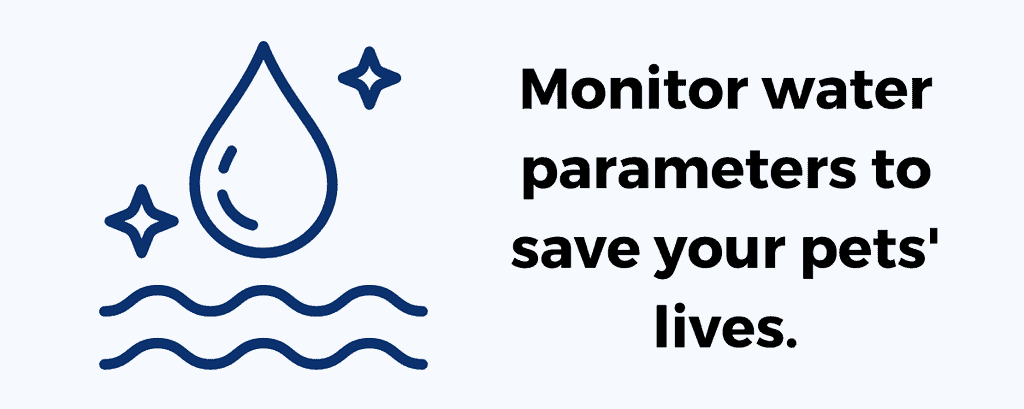
Aside from shell problems, nerite snails face a lot of similar illnesses to other fish and snails.
Parasites, bacterial infections, and stress all take a toll on them.
Stress is the most common and comes from several different places:
- Water temperature/pH changes
- High chemical levels
- Aggressive fish
- Harsh lighting
Fortunately, these are all things you have control over.
Monitoring chemical levels and other water parameters on a regular schedule might save your pets’ lives.
Observing how your fish or shrimp get along with your snails is also a great safety measure.
Look for signs of stress:
- Lethargy
- Hiding for long periods
- Color variations
- Loss of appetite
When you notice these symptoms, something isn’t right. Don’t wait to check the water and make some changes.
If it isn’t the water, your snail is probably sick.
What to Look for When Buying Nerite Snails
Do
- Compare Prices
- Ask about previous care
- Get your supplies ahead of time
- Ask about previous tank mates
- Seek out young snails
Do Not
- Buy the first snail you see
- Buy a sick or poorly cared for snail
- Buy the tank & snail together
- Put shy snails with aggressive fish
- Buy snails older than a year old
It’s tricky buying snails for the first time.
They are widely available, but many pet stores and aquarists know very little about them.
Buying from a breeder directly is a good goal. But for some of you, it just isn’t practical.
So, take some precautions. Ask about age, care history, and whether they are used to living with other fish or snails.
These things will help you get to know the snails a little bit and ultimately will tell you whether or not they’re a good fit for your tank.
Nerite Snail Tank Mates

Nerite snails are sweethearts who do well in freshwater and saltwater alike, which makes them easy-to-love tank mates.
But they do have specific tank requirements. So, whoever you pair them with, those requirements need to be met.
If your fish needs a temperature of 78-84° degrees Fahrenheit (29° C), they won’t do well with a nerite snail which needs a temperature of 72-78° degrees Fahrenheit (26° C).
The overlap is too small!
The other key is to keep your snails with friendly fish that aren’t likely to attack or eat them.
Cichlids would be terrible roommates for them!
Here’s our list of some of the best tank mates for nerites:
- Betta fish
- Guppies
- Neon or cardinal tetras
- Rasboras
- Barbs
- Dwarf gouramis
- Ghost shrimp
- Cherry shrimp
Nerite Snails and Betta Fish
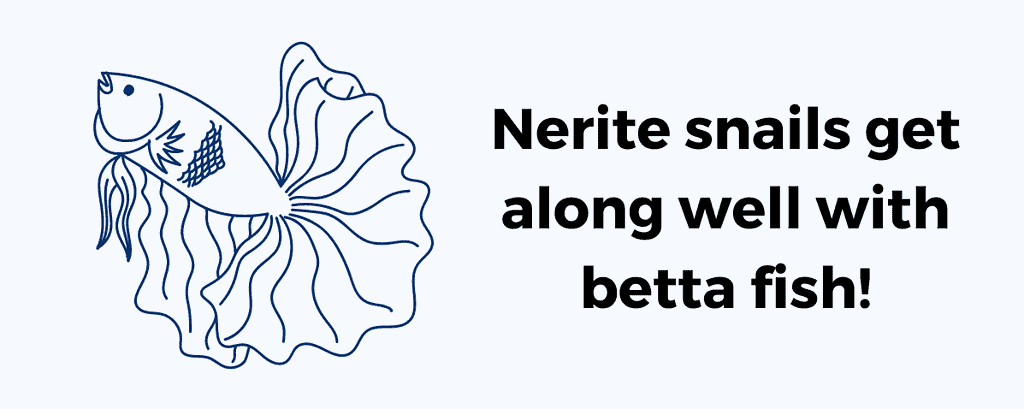
Nerite snails get along well with betta fish! They don’t reproduce in a freshwater tank (which is what betta fish need) but do a great job helping you keep a clean tank.
They also eat up the algae growth your betta fish need protection from.
Picking the substrate for a betta and nerite snail tank would be a bit of a challenge.
You may also notice betta fish like a lower pH than nerite snails. Truth be told, nerites do okay at a pH of 7.
As long as the pH stays between 7 and 7.5, your snails and betta would be happy.
It’s okay to make small compromises if you keep an eye on how your pets handle their environment.
So when do you need to separate your pets?
If your fish are constantly harassing or hurting your snails, things will probably not work out.
When your snails, fish, or both show signs of stress or sickness, the water or the relationship is likely not where it needs to be.
While we listed fish that generally do very well with nerite snails, there is no guarantee you won’t have problems housing them together.
Have a backup plan in case things don’t work out.
For example, if you have a second tank, you can separate the fish and snail(s) at a moment’s notice.
Caring for Your Algae Eater
Nerite snails are quiet and easy to care for but a little more difficult to breed.
They make great snails for beginner aquarists because they do well in saltwater or freshwater and are good tank mates to many varieties of fish.
The aquarist community favors them as one of the best algae eaters and a go-to for shared fish tanks.
If you know someone who’s deciding on what kind of snail to get or needs some help with snail care, send them this article.


